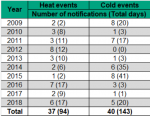Extreme Weather
Extreme Weather
Extremes in the outdoor ambient air temperature can pose serious implications for human health. For example, in Ontario it has been estimated that each 5°C change in daily temperature resulted in an additional seven deaths per day in cold seasons, and four excess deaths during warm weather.1 Ontario public health units issue extreme heat and cold weather notifications to alert local residents and agencies about extreme heat or cold events, to help ensure that vulnerable populations and those who work with them take measures to reduce the risk of illness or death.
Between 2009 and 2018, the number of extreme heat and cold weather notifications varied depending on the year, with no obvious pattern of year-by-year increase or decrease. However, across the 10-year time period the number of days the Middlesex-London region was under a cold weather advisory was more than 50% greater compared to those related to extreme heat.
Extreme heat or cold weather notifications
View more information about extreme heat or extreme cold.
Between 2009 and 2018, the annual number of heat notifications issued for the Middlesex-London region ranged between one and eight. The greatest number of heat events was in 2012. The range in the annual number of cold weather notifications was similar, from no notifications in 2012 to a high of eight in both 2009 and 2015 (Figure 14.2.1).
While the number of extreme heat (n=37) and cold (n=40) notifications was comparable across the 10-year time period, the number of corresponding days under an advisory differed. Between 2009 and 2018, the total number of days the Middlesex-London region was affected by extreme cold weather (n=143) was more than 50% greater than the number related to extreme heat (n=94) (Figure 14.2.1).
Between 2009 and 2018 there was a similar number of extreme heat and cold notifications, with no obvious pattern of year-by-year increase or decrease. Across the 10-year time frame, the Middlesex-London region experienced a greater number of extreme cold days compared to those related to heat.
The Middlesex-London Health Unit issues three different types of heat notifications: heat alerts, heat warnings, and extended heat warnings. All heat-related alerts and warnings were included the heat notifications included in this topic.
A heat alert is issued by the Middlesex-London Unit when at least one of the following criteria is met:
1) The Environment Canada forecast calls for a daily maximum temperature of 31°C or higher, or
2) The Environment Canada forecast calls for a daily Humidex of 40°C or higher.
A heat warning is issued when at least one of the following criteria is met:
1) The Environment Canada forecast calls for a daily maximum temperature of 31°C or higher with a minimum low of 20°C or higher for two consecutive days, or
2) The Environment Canada forecast calls for a daily Humidex of 40°C or higher for two consecutive days.2
An extended heat warning is issued when at least one of the following criteria is met:
1) The Environment Canada forecast calls for a daily maximum temperature of 31°C or higher with a minimum low of 20°C or higher for three consecutive days or longer, or
2) The Environment Canada forecast calls for a Humidex of 40°C or higher for three consecutive days or longer.2
The Middlesex-London Health Unit issues only one type of cold weather notification: cold alerts. A cold alert is issued when any one of the following criteria is met:
1) The Environment Canada forecast calls for a daily temperature of -15°C or lower, or
2) The Environment Canada forecast calls for a wind chill temperature of -20°C or lower, or
3) Environment Canada issues a Cold Alert or Cold Warning for the region, or
4) Other forms of extreme weather are present, such as a blizzard or ice storm.
Ontario Public Health Standards: Requirements for Programs, Services, and Accountability – Healthy Environments (pages 33-35)
Healthy Environments and Climate Change Guideline
Population Health Assessment and Surveillance Protocol, 2018
References:
1. Chen H, Wang J, Li Q, Yagouti A, Lavigne E, Foty R, Burnett RT, Villeneuve PJ, Cakmak S, Copes R. Assessment of the effect of cold and hot temperatures on mortality in Ontario, Canada: a population-based study. CMAJ Open [Internet]. 2016 Feb 2 [cited 2019 Nov 4];4(1):E48-58. Available from: http://cmajopen.ca/content/4/1/E48.long doi: 10.9778/cmajo.20150111
2. Ontario Ministry of Health. A harmonized heat warning and information system for Ontario (HWIS) [Internet]. Toronto (ON): Queen’s Printer for Ontario; c2009-2019 [modified 2018 Nov 9; cited 2019 Oct 30]. [about 13 p.]. Available from: http://www.health.gov.on.ca/en/common/ministry/publications/reports/heat...
Last modified on: November 19, 2019
